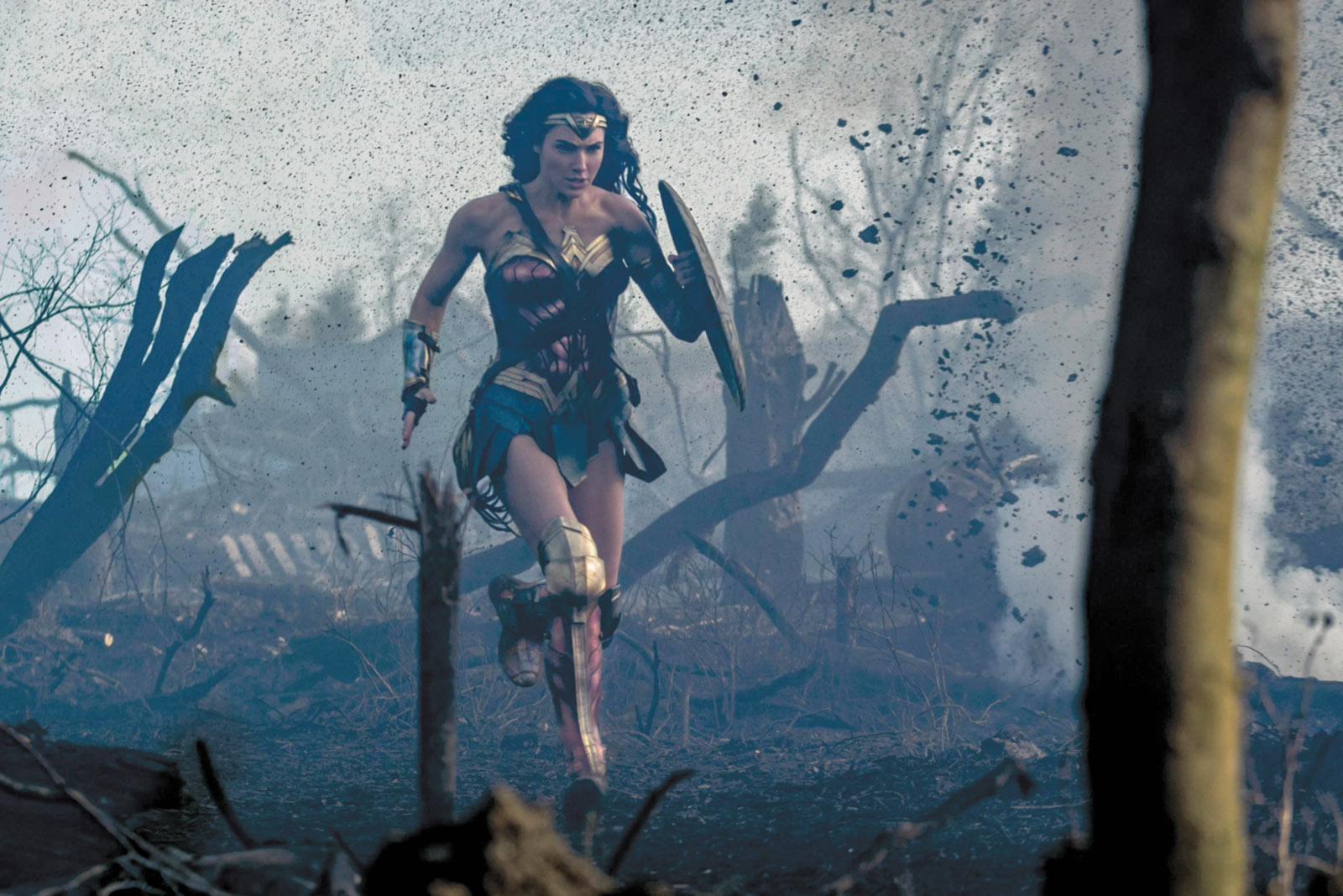The United Nations has ended a campaign featuring Wonder Woman as an ambassador for women and girls, two months after the announcement was met with protests and a petition complaining that the fictional superhero was an inappropriate choice to represent female empowerment…. “A large-breasted white woman of impossible proportions, scantily clad in a shimmery, thigh-baring body suit with an American flag motif and knee-high boots” is not an appropriate spokeswoman for gender equity at the United Nations, the petition said.
—The New York Times, December 13, 2016
Perhaps the greatest service that the director Patty Jenkins does her protagonist in Wonder Woman, the Warner Brothers blockbuster released this June, is to give her a new set of clothes. The female superhero has been charged with various ideological impurities over the years—jingoism, a too-cozy relationship with America’s military-industrial complex, an excessively heteronormative lifestyle—but by far the most frequent complaints have been about her man-pleasing, bondage-inflected get-up. Those go-go boots! Those bracelets of submission! That quivering embonpoint! It’s hard to be taken seriously as a feminist icon when the only thing you’ve got to wear to work is a star-spangled corset.
The costume worn by Wonder Woman’s star, the Israeli actress and former beauty queen Gal Gadot, is altogether more stern. The kinky boots have been replaced by a pair of gladiatorial thigh-highs; the body suit, constructed out of some cunning alloy of spandex and bronze, is, if not quite armor, at least armor-themed. The outfit isn’t much less revealing, and only marginally more practical, than the old one. (It’s still strapless and her legs must still get rather chilly when she’s stalking villains in cold climates.) But it does at least communicate some martial ferocity and menace. Thus attired, Wonder Woman might plausibly intimidate even her haters at the UN.
Sadly, whatever fresh potency she has acquired from the wardrobe department is offset by the film’s anxious insistence on demonstrating the femininity that lies beneath her breastplate. (Both Jenkins and Gadot have acknowledged that their great goal was to avoid making Wonder Woman look like “a ballbuster.”) Au fond, we are repeatedly assured, Wonder Woman is a very simple, soft, “relatable” lady. She adores babies and ice cream and snowflakes. She is sweetly oblivious to her own beauty and its devastating effects on those around her. She has absolutely no problem with men. She loves men! In fact, once she’s left her Amazon family behind, she barely bothers talking to another woman for the rest of the movie. Gadot has real presence and charm as an actress—one longs to see her in something worthier of her talent. But the imperative to eradicate any hint of bossiness or anger from her character weighs heavily on the film, threatening to turn it into one long, dispiriting exercise in allaying male fears about powerful women.
There are some pleasures to be found in its 141 minutes—most notably, in the opening depiction of Wonder Woman’s Amazon childhood. The scenes set on the Amazons’ island home of Themyscira—envisioned here as a sort of second-century Canyon Ranch for lesbian separatists—have the enjoyably campy feel of a 1960s sword-and-sandal epic. All of the Amazons are blessed with excellent bone structure and deportment, and speak in the solemn, “for tomorrow we rise at dawn” locutions of Hollywood-style antiquity. They have been entrusted by Zeus with the task of defending the world against his rebellious son, Ares, and they spend their days honing their military skills for this purpose. (Their proud and elegant form of female aggression requires a lot of leaping through the air in the postures of avenging angels and hanging at half-mast from galloping steeds.)
Wonder Woman—or Princess Diana, as she is known to her people—is the only child in this happy island gynocracy, and her protective mother, Queen Hippolyta (Connie Nielsen), who claims to have created her by carving her out of clay and getting Zeus to breathe life into her, does not want her to become a warrior. Diana’s aunt, Antiope, played by Robin Wright and her phenomenal cheekbones, is tougher-minded: she knows that it is Diana’s unavoidable destiny to one day save the no-goodnik patriarchy from Ares. She has appointed herself Diana’s personal trainer and life coach, and is always exhorting her, in the manner of a Homeric-era Sheryl Sandberg, to aim higher and work harder:
You have greater powers than you know…. You expect the battle to be fair; the battle will never be fair…. Be careful in the world of men, Diana. They do not deserve you.
Alas, our sojourn with the fabulous ladies of Themyscira ends all too soon. One day, a World War I German fighter plane comes zooming through the magical force field that surrounds the island. The man in it, Steve Trevor (played by Chris Pine), isn’t really a German but an American spy who has just stolen a chemical weapon formula from an evil German scientist, and is now being pursued by a platoon of enemy soldiers. (Something incorrigibly twenty-first-century in Pine’s bearing keeps him from being entirely persuasive in this role; you can put this man in a foxhole on the Western Front and he still looks like someone on his way to the Coffee Bean and Tea Leaf for a mocha skim latte.) After a beachfront battle between the Amazons and the Germans (during which noble Antiope is fatally wounded), Diana uses her lasso of truth to find out Steve’s real identity and mission. On hearing his account of “the war to end all wars,” she becomes convinced that the time has come for her to go out and conquer Ares and, with Steve, she sets sail for England.
Advertisement
Our departure from Themyscira is sad for many reasons, not least because it marks the last time we will see any sun. Dominated by purplish-gray lighting, relentlessly louring skies, and lugubrious, CGI-enhanced battle scenes, the next two hours nicely simulate the experience of being trapped in a windowless video game arcade. “It’s hideous,” Diana says on first glimpsing the smoke-wreathed cityscape of London—a comment that might safely be applied to the rest of the movie.
Rumors of the heat and wit of the Diana–Steve partnership have been somewhat exaggerated. The comedy of their relationship is generated largely by her ignorance of early-twentieth-century manners, particularly as they pertain to relations between the sexes. Unlike the Diana of the comic book, who arrived in America already au fait with the social mores and politics of the place, this Diana is a stranger in a strange land, perpetually and adorably perplexed by the ways of men. (The film’s screenwriter, Allan Heinberg, apparently took his inspiration for her fish-out-of-water predicament from Disney’s Little Mermaid.) She doesn’t know that it is improper to ask a man questions about his anatomy while gazing coolly at his naked form in the bath; she is unaware that an invitation to sleep with someone means something more than sleeping next to them.
Diana is also oblivious to the fact that in the London of 1918, her sex radically limits her freedoms. She cannot see why she would be barred from attending an all-male parliamentary meeting, or why she would be expected to constrain her waist with a corset. (A bit rich, this, given that the Wonder Woman costume performs much the same function.) When Captain Steve’s secretary, Etta Candy, explains that her job involves doing whatever her boss asks her to, Diana frowns and remarks, “Where I come from, we would call that slavery.”
This—a sly reference to the ignominious moment in comic book history when Wonder Woman was relegated to being secretary of the Justice League—is a feminist joke of sorts. But it’s not a joke that Diana gets. Unlike the comic book Diana, who was always dashing about giving pep talks to abused wives (“Get strong! Earn your own living!”) and reporting back to her mother on the progress of women’s rights, Diana remains blissfully ignorant of the women’s cause. The male sidekicks who accompany her and Steve to the war in Europe teach her about racial prejudice, the plight of Native Americans, and even the horrors of PTSD, but somehow the news that women don’t have the vote evades her.
Maintaining her ignorance is of course a quite deliberate maneuver—part of the film’s scrupulous endeavor to keep any hint of ball busting at bay. (“It was important to me,” Gadot told Entertainment Weekly, “that my character would never come and preach about how men should treat women. Or how women should perceive themselves.”)
A similar effort to avoid having Diana become too domineering is evident in the careful way that she and Steve are presented as equal partners in their mission. One good man, apparently, is equal to an Amazon demigoddess. (Gadot: “We didn’t want to make Steve the damsel in distress.”) If Diana has the muscle, it’s Steve who has the tactical sense and the job of mansplaining the true nature of their mission. (She’s under the impression that if she manages to kill Ares, she will end war forever.)
Steve is also, it turns out, the person who gives her the correct moral position on man’s inhumanity to man. At the climax of her final, set-piece battle with Ares (who is not the German general she had initially fingered, but a British politician posing as her and Steve’s friend), Ares tries to persuade her that human beings are too corrupt and nasty to deserve her help—an idea initially proposed by Antiope. But Steve’s selfless actions and the power of their newly blossomed love have taught her to reject such cynicism. “It’s not about deserve, it’s about what you believe,” she says. “And I believe in love.”
Advertisement
The exact meaning of this homily is somewhat obscure. It has a Clintonian “Love Trumps Hate” ring to it, certainly. But why it compels her to take mercy, at the last minute, on Dr. Poison, the crazed German scientist who has been plotting to kill thousands with a lethal poison gas, is a mystery. What is the moral equation of ruthlessly dispatching hundreds of German grunts, only to spare the architect of the war’s most dastardly tactics? Never mind. The important thing is that it is Steve and the lightning strike of romantic love that has given her this wisdom.
An astonishing number of women critics have reported being moved to tears by Gadot’s performance. They have hailed Wonder Woman as an inspiring vision of female strength; a landmark in pop-cultural depictions of woman; an exultant portrait of pussy power in excelsis, perfectly timed to rouse our spirits in the dark era of Trump. But the film is far too cautious and focus group–tested an enterprise to be any of these things. Like so many recent girl-power extravaganzas that seek to celebrate what a long way we’ve come, baby, it ends up illustrating precisely the opposite.
Wonder Woman in the comics was famously enfeebled during the 1950s when a set of new writers took over and turned her into a fashion model, a babysitter, an agony aunt. Wonder Woman does nothing so crude. It allows its heroine all the trappings of free, courageous, independent womanhood. It even cheers her on when she bashes up men. It merely propagates the unhelpful myth that if a woman is nice enough, pretty enough, feminine enough, she can do such things without ever causing offense, or being called a bitch. Really, if you want feminist inspiration, you’re better off skipping Wonder Woman and going back to watch the wiseacre heroines of the 1940s: the ones played by Bette Davis, Katharine Hepburn, Rosalind Russell, and Barbara Stanwyck. They were wittier and gutsier and not half as worried about busting balls.



